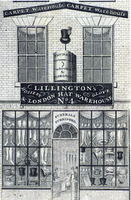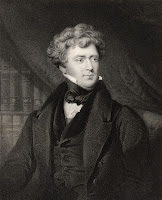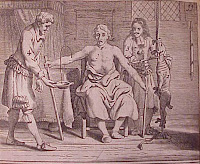So I was all set to do this stupendous post about my corset. I visited the staymaker last Saturday armed with my camera and found the batteries had died. So much for that, but my staymaker is indeed hard at work making me a front-lacing corset, and I should say that it is a garment made of stout cotton for my equally stout body, without any ooh la la factor at all, as is the linen shift that I will wear with it.
 By one of those strange internet associations I went searching on google for the term “liberty bodice.” Bet you don’t know what a liberty bodice is. Aunt Ada Doom in Cold Comfort Farm sends Judith to find hers when she decides to make a family appearance (great book and excellent movie with a terrific cast including Rufus Sewell as the earthy stud Seth).
By one of those strange internet associations I went searching on google for the term “liberty bodice.” Bet you don’t know what a liberty bodice is. Aunt Ada Doom in Cold Comfort Farm sends Judith to find hers when she decides to make a family appearance (great book and excellent movie with a terrific cast including Rufus Sewell as the earthy stud Seth).
The Way to Healthy Development
Free and unrestricted exercise is necessary to healthy growth and development. That is why most mothers choose the “Liberty” Bodice for their children. It gives firm yet gentle support, allows perfect bodily freedom, and transfers the weight of underclothing and “pull” of suspenders to the shoulders. The most hygienic garment made. Wears well and washes splendidly.
 Yes, it was the late 19th-early 20th century unisex equivalent of a training bra, probably a direct descendant of the stays that were worn by children in the Georgian period and possibly also worn by elderly women, like Aunt Ada Doom, who’d decided to give up the discomfort of a corset (and by this period they would be uncomfortable). This article about a museum exhibit celebrating the 100th anniversary of the garment, states the factory went out of business in the 1960s. Wow. You do have to wonder, though, about what sort of garments would be termed unhygienic.
Yes, it was the late 19th-early 20th century unisex equivalent of a training bra, probably a direct descendant of the stays that were worn by children in the Georgian period and possibly also worn by elderly women, like Aunt Ada Doom, who’d decided to give up the discomfort of a corset (and by this period they would be uncomfortable). This article about a museum exhibit celebrating the 100th anniversary of the garment, states the factory went out of business in the 1960s. Wow. You do have to wonder, though, about what sort of garments would be termed unhygienic.
 Here’s a pair of children’s stays from the mid 18th-century, made of wool with boning and back lacing. Stand up straight, child! Yes, our manly heroes probably wore something like this (and a gown!).
Here’s a pair of children’s stays from the mid 18th-century, made of wool with boning and back lacing. Stand up straight, child! Yes, our manly heroes probably wore something like this (and a gown!).
 So, tearing myself away from underwear reminiscences and explorations, let me move on to the beer. That, with books, is what the Baltimore Book Festival is all about, and it takes place this weekend. I’ll be there for a few hours beginning at noon on Saturday, reading from Jane Austen: Blood Persuasion, talking about historical romance (and serving tea!) and talking about Jane Austen. Stop by and say hello! I’ll also be raffling off this fine basket of Austen-vamp related items, which includes tea, a teapot, a gorgeous red and black silk scarf, and various other delectable odds and ends.
So, tearing myself away from underwear reminiscences and explorations, let me move on to the beer. That, with books, is what the Baltimore Book Festival is all about, and it takes place this weekend. I’ll be there for a few hours beginning at noon on Saturday, reading from Jane Austen: Blood Persuasion, talking about historical romance (and serving tea!) and talking about Jane Austen. Stop by and say hello! I’ll also be raffling off this fine basket of Austen-vamp related items, which includes tea, a teapot, a gorgeous red and black silk scarf, and various other delectable odds and ends.
If you’re green with envy and hundreds of miles from Baltimore, I’m giving away very similar prizes in my most recent contest. If you receive my newsletter, you don’t need to do anything at all: you’re already entered for the drawing (you should have received an issue yesterday if all goes well). If you don’t yet receive my newsletter (and why not? It’s infrequent, mostly harmless, and occasionally amusing) sign up on my website and you’ll be entered for Austen-vamp prize #2. While you’re there you can also read an excerpt from Jane Austen: Blood Persuasion and check out my Blog Tour. I’ll do the contest drawing and announce the winners on October 27.
Do you have a book event in your town? What would your dream line up for a book event be?


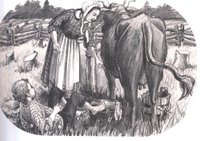
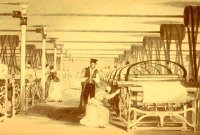
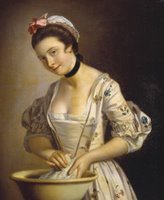
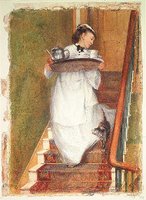 Or, you might go into service. Here’s another amazing statistic: in the eighteenth century, one-third of all the population (with the exception of the aristocracy) was in service at some time in their lives—usually until their mid-twenties. About one-third of London’s population was servants. Some people, working in the houses of the rich, rose in the ranks to enter the servant elite as butler, housekeeper, or lady’s maid; even though this illustration is from the mid-eighteenth century, you can see how well-dressed this lady’s maid is. Servants earned room and board, plus “perks”—for a ladies maid or valet, cast-off clothing they could wear or sell—or “vails,” tips from visitors usually given to footmen.
Or, you might go into service. Here’s another amazing statistic: in the eighteenth century, one-third of all the population (with the exception of the aristocracy) was in service at some time in their lives—usually until their mid-twenties. About one-third of London’s population was servants. Some people, working in the houses of the rich, rose in the ranks to enter the servant elite as butler, housekeeper, or lady’s maid; even though this illustration is from the mid-eighteenth century, you can see how well-dressed this lady’s maid is. Servants earned room and board, plus “perks”—for a ladies maid or valet, cast-off clothing they could wear or sell—or “vails,” tips from visitors usually given to footmen. 